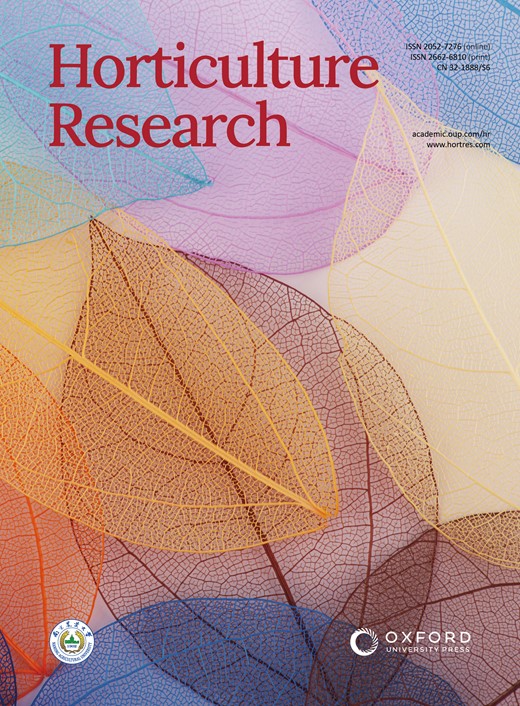SlSTOP1-regulated SlHAK5 expression confers Al tolerance in tomato by facilitating citrate secretion from roots
IF 8.7
1区 农林科学
Q1 Agricultural and Biological Sciences
引用次数: 0
Abstract
SENSITIVE TO PROTON RHIZOTOXICITY 1 (STOP1) is a core transcription factor that regulates the expression of aluminum (Al)-resistance genes to manage Al toxicity in plants. However, the genome-wide roles of SlSTOP1 in the Al stress response of tomato (Solanum lycopersicum) remain largely unknown. Here, we report that SlSTOP1 is crucial for Al tolerance in tomato, as loss-of-function mutants of SlSTOP1 displayed hypersensitivity to Al stress. Aluminum stress had no effect on SlSTOP1 mRNA expression, but promoted accumulation of SlSTOP1 protein in the nucleus. Through integrated DNA affinity purification sequencing and RNA sequencing analysis, we identified 39 SlSTOP1-targeted Al-responsive genes, some of which are homologous to known Al resistance genes in other plant species, suggesting that these SlSTOP1-targeted genes play essential roles in Al resistance in tomato. Furthermore, using peak enrichment analysis of SlSTOP1-targeted sequences, we identified a cis-acting element bound by SlSTOP1 and validated this finding via dual-luciferase reporter and electrophoretic mobility shift assay (EMSA). Additionally, we demonstrated SlHAK5 is one of direct targets of SlSTOP1 and functionally characterized it in terms of Al stress tolerance. Compared with wild-type plants, Slhak5 mutants developed by CRISPR/Cas9 technology presented increased sensitivity to Al stress, which was associated with reduced citrate secretion from the roots. Together, our findings demonstrate that SlSTOP1 directly interacts with cis-acting elements located in the promoters of target genes involved in diverse pathways contributing to Al resistance in tomato.SlSTOP1 调控的 SlHAK5 表达通过促进根部柠檬酸盐分泌赋予番茄耐碱性
SENSITIVE TO PROTON RHIZOTOXICITY 1(STOP1)是一个核心转录因子,可调控铝(Al)抗性基因的表达,从而控制植物的铝毒性。然而,SlSTOP1 在番茄(Solanum lycopersicum)铝胁迫响应中的全基因组作用在很大程度上仍然未知。在这里,我们报告了 SlSTOP1 对番茄耐碱性的关键作用,因为 SlSTOP1 的功能缺失突变体对铝胁迫表现出超敏反应。铝胁迫对 SlSTOP1 mRNA 的表达没有影响,但促进了 SlSTOP1 蛋白在细胞核中的积累。通过DNA亲和纯化测序和RNA测序综合分析,我们发现了39个SlSTOP1靶向的铝响应基因,其中一些与其他植物物种中已知的铝抗性基因同源,表明这些SlSTOP1靶向基因在番茄的铝抗性中发挥着重要作用。此外,利用 SlSTOP1 靶向序列的峰值富集分析,我们确定了 SlSTOP1 结合的顺式作用元件,并通过双荧光素酶报告和电泳迁移分析(EMSA)验证了这一发现。此外,我们还证明了 SlHAK5 是 SlSTOP1 的直接靶标之一,并从耐碱胁迫的角度对其进行了功能表征。与野生型植物相比,通过 CRISPR/Cas9 技术培育的 Slhak5 突变体对铝胁迫的敏感性增加,这与根部柠檬酸盐分泌减少有关。总之,我们的研究结果表明,SlSTOP1 直接与位于靶基因启动子中的顺式作用元件相互作用,这些靶基因参与了番茄抗铝的多种途径。
本文章由计算机程序翻译,如有差异,请以英文原文为准。
求助全文
约1分钟内获得全文
求助全文
来源期刊

Horticulture Research
Biochemistry, Genetics and Molecular Biology-Biochemistry
CiteScore
11.20
自引率
6.90%
发文量
367
审稿时长
20 weeks
期刊介绍:
Horticulture Research, an open access journal affiliated with Nanjing Agricultural University, has achieved the prestigious ranking of number one in the Horticulture category of the Journal Citation Reports ™ from Clarivate, 2022. As a leading publication in the field, the journal is dedicated to disseminating original research articles, comprehensive reviews, insightful perspectives, thought-provoking comments, and valuable correspondence articles and letters to the editor. Its scope encompasses all vital aspects of horticultural plants and disciplines, such as biotechnology, breeding, cellular and molecular biology, evolution, genetics, inter-species interactions, physiology, and the origination and domestication of crops.
 求助内容:
求助内容: 应助结果提醒方式:
应助结果提醒方式:


